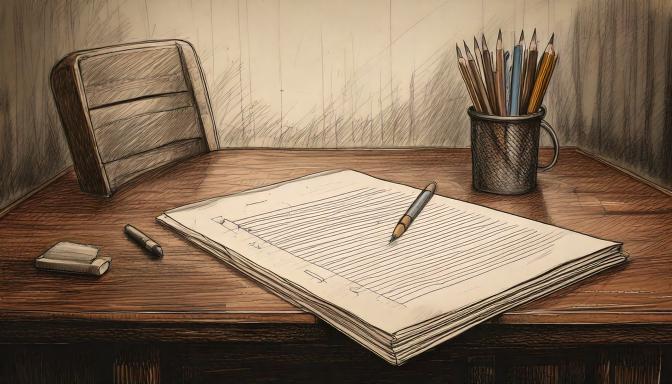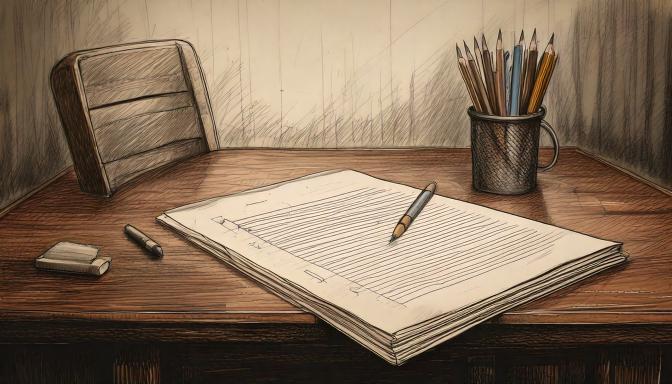Story Writing Tips

One rainy afternoon, Taniya again came storming into my room—yes, quite literally—with a notepad in one hand and a big frown on her face.
I raised an eyebrow. “What’s cooking in your dramatic head, Tani?”
She dropped the notepad on my bed and flopped beside me. “Yaar, I’ve been trying to write a story, and I want to make my scenes super intense—you know, like edge-of-the-seat, popcorn-falling-from-your-hand type. But I don’t know how to do it!”
I tried not to laugh, but come on, Tani was being so dramatic. “Hogaya Tera?(Are you done talking?) Come sit, Miss Filmfare. Let me show you the magic formula for writing heart-stopping scenes.” I said, trying to keep a straight face.
She perked up instantly. “Wait, wait—let me grab a pen!”
I snatched the pen from her hand. “Nope. No notes right now. Just listen. Soak it in. We’ll write it down later. Storytelling isn’t about copying steps—it’s about feeling them.”
Taniya sighed but nodded. “Okay fine. Tell me everything.”
Step 1: Crank Up the Tension
I leaned closer like I was about to share the most secret of secrets.
“Building tension is like winding up a toy—it gets tighter and tighter until it explodes! The goal is to make your reader feel nervous, excited, curious... all at once.”
“Okay,” she said. “Like when you know something scary is about to happen in a horror movie but it hasn’t happened yet?”
“Exactly!” I said, snapping my fingers. “Let’s say your character, Zoey, is sneaking into an old, haunted mansion.”
I lowered my voice for dramatic effect. “The floor creaks under her foot. There’s a chill in the air. Cobwebs brush her arms. And just then—a faint knock echoes from upstairs.”
Taniya’s eyes widened. “Okay whoa—goosebumps! I would totally be holding my breath.”
“Boom! That’s what you want your readers to feel.”
Taniya looked thoughtful. “So, it’s all about building a feeling of dread, right?”
“Exactly! Tension should make your reader feel uncomfortable. When they’re on the edge of their seat, they’re more engaged. They want to know what’s going to happen next. So, keep them guessing.”
Step 2: Throw in Tough Decisions
“Now imagine,” I continued, “Zoey hears footsteps behind a locked door. What should she do?”
“Run?” Taniya said.
“Sure. But what if she hides? What if she opens the door instead? Or...pretends to be a ghost to scare the other person away?”
Taniya giggled. “A ghost? That’s epic!”
“See? Giving your character a tough choice raises the stakes. Readers love not knowing what’ll happen next. The harder the choice, the more tension you build.”
Taniya looked like she was piecing it together. “So, it’s like the more pressure you put on your character, the more interesting the scene gets?”
“Exactly! When characters face impossible decisions, readers don’t just read the story—they feel it. They’ll start imagining what they would do in that situation.”
Step 3: Master the Pace
Taniya narrowed her eyes. “But won’t people get bored if I slow it down?”
I shook my head. “No no! Slowing things down in the right places actually builds suspense. You stretch the moment until it snaps. Like this:”
“Zoey stepped closer to the door, her breath shallow. Her fingers brushed the cold knob. Silence pressed in around her.”
Taniya whispered, “And then?”
“She turned the handle. The door burst open—BOOM!”
“See that?” I grinned. “That’s how you control the pace—slow for suspense, fast for the action. It’s like directing your own movie!”
Taniya seemed to think for a moment. “So, you slow it down so the reader feels the tension... then hit them with the action before they can blink?”
“Exactly. It’s all about playing with time. Stretching it, then speeding it up. You want the reader to feel like they’re living in the moment with your character.”
Step 4: Prepare for a Shocking Twist
“Now, just when the reader thinks they know what’s going on—twist it!” I said, making a twisting motion with my hand.
“Like what kind of twist?” Taniya asked, curious.
“Let’s say Zoey thinks she escaped, but bam! Someone grabs her ankle from under the bed. Or she finds a secret note that changes everything. The key is to plant tiny clues earlier so the twist feels real—but still shocking.”
Taniya looked impressed. “Okay I’m loving this! But I don’t want the twist to be too predictable…”
“Then don’t make it obvious,” I replied. “Drop hints, not spoilers.”
Taniya nodded thoughtfully. “So, the twist should surprise them, but it shouldn’t come out of nowhere?”
“Exactly! The best twists are the ones that make readers say, ‘I should have seen that!’—but they didn’t.”
Step 5: Make the Action Count
“Now comes the action,” I said, standing up and pretending to run. “Imagine Zoey is being chased through a forest.”
I spoke fast, mimicking the chaos:
“Her feet pounded the wet ground. Branches whipped her face. Behind her—footsteps. Fast ones. Getting closer.”
“Short sentences, quick movements, big stakes,” I said, out of breath.
Taniya clapped. “That was SO good! I was running with her in my head!”
“Exactly what you want,” I said. “Make your reader feel the action. Every heartbeat. Every breath.”
Taniya raised an eyebrow. “So, even the action has to be emotional? It’s not just about running or fighting?”
“Yes! Make every action meaningful. Make the reader feel like they’re right there with your character—scared, nervous, and breathless.”
Step 6: Switch Things Up
“But,” I added, holding up a finger, “you can’t keep things high-stakes all the time. Let the reader breathe.”
“So... give them a break?” she asked.
“Yup. Like Zoey finds a trapdoor and hides. She thinks she’s safe. The reader relaxes. But then...”
Taniya jumped in: “The bad guy appears at the trapdoor!”
I gave her a proud nod. “Yes! Let the reader think it’s over—then bring the danger right back. That’s how you keep them on their toes.”
Taniya looked satisfied. “Ah, so you want to keep surprising them. Just when they think they’ve got a moment to relax, you hit them again.”
“Exactly! Keep them on edge. You want them thinking, ‘What now?’”
Step 7: End with a Bang
“And finally,” I said, “don’t wrap up your scene too neatly.”
“You mean—leave it on a cliffhanger?” Taniya asked.
“Bingo. Cliffhangers are like those ‘Next Episode’ buttons on Netflix. Readers have to keep going.”
“Like Zoey opens the treasure chest... and gasps. But you don’t tell what’s inside!” Taniya said, eyes gleaming.
“You’re catching on fast!” I laughed. “Leave just enough mystery that they have to turn the page.”
Taniya’s eyes shone with excitement. “I’m totally going to use that. Keep them hanging, then hit them with more!”
Taniya sat back, looking completely inspired.
“I feel like I’ve learned a storytelling superpower,” she said, eyes wide.
I winked. “You have. Now go write that jaw-dropping scene and make your readers beg for more.”
Taniya stood up dramatically, clutching her imaginary Oscar. “I’d like to thank my mentor, my teacher, my best friend…”
“Get lost and go write, you drama queen,” I laughed, throwing a cushion at her.
We both burst out laughing, and just like that, Taniya went from unsure beginner to fired-up storyteller.
Key Takeaways for Writing Heart-Stopping Scenes
- Crank Up the Tension – Use small, sensory details and suspense.
- Throw in Tough Decisions – Give characters impossible choices.
- Master the Pace – Slow down for suspense, speed up for action.
- Prepare for a Shocking Twist – Surprise your readers, but plant clues.
- Make the Action Count – Use urgency, movement, and short bursts of action.
- Switch Things Up – Give moments of relief, but don’t let it last.
- End with a Bang – Use cliffhangers to keep readers hooked!










